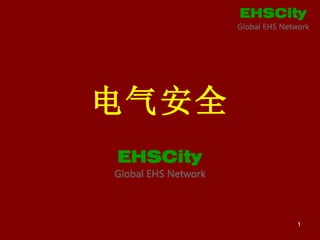
Electrial Safety 电气安全 EHSCity
Editor's Notes
- Grounding creates a low-resistance path from a tool to the earth to disperse unwanted current.
- 过载和过电流不是一个意思 过载只是负荷超过额定值,当然,也产生过电流。 过流,则有许多原因。其中过载是一种,但多数的过流并不是过载引起的,而是故障引起的,如电动机的缺相运行、线路轻微短路、接地等。 电机卡住,这是一种极严重的过载,电流极大。如果不能及时断开电源,电机会很快烧掉。 电机卡住时,电流很大,机械功几乎为 0 ,电流大量做热功,线圈急剧发热。
- An incident reporting kit contains the following items and is a means for you to report an incident to your local office.
- An incident reporting kit contains the following items and is a means for you to report an incident to your local office.
- The General Safety Rules of the policy are general fleet safety rules and are designed to prevent the employee from being involved in an incident. Here are some examples of those rules. Refer also to the Critical Safety Rules for a discussion regarding impaired driving. Always wear your seatbelt, no matter how short or routine your trip. After all, half the fatal head-on crashes occur at 35 mph or less. Drive with daytime running lights on. Recent studies show that vehicles with daytime running lights on are less likely to be involved in an accident. All tools and cargo should be secured to prevent distractions to the driver. Unsecured cargo can also cause injury to the driver in an accident.
- The leading cause of rear-end collisions is following too closely. When driving in traffic some questions to ask yourself are: Am I at a safe following distance? How am I measuring my safe following distance? What is my total stopping distance?
- Employees have also used the kits to record injuries, unsafe work conditions in their work environment. The kit is a tool and you are allowed to use as necessary to document safety issues and concerns.
- All vehicle incidents, regardless of severity should be reported to your local office. Collect as much information as possible by utilizing the Incident Reporting Kit. As an organization, we need to focus on driving incidents and provide better training and resources to you. Without data, we cannot help you prevent future incidents.
- Following too closely, driving too fast for conditions, aggressive driving behavior, inattentive driving, distractions, and fatigue are the most common causes of rear-end collisions. Throughout this presentation we will look at these causes and some common preventative actions.
- As mentioned in the previous slide, employees will be sit down with their manager and develop a corrective action plan to improve their driving habits. The goal of the corrective action plan is to help the employee and prevent them from seriously hurting themselves or someone else. It is expected the employee will follow the corrective action plan or be subject to further discipline.
- Our accident costs have totaled over 1.5 million dollars annually. In looking at our losses, rear-end collisions are the most frequent and costly accidents. Fifty-five percent of all our accidents are rear-end collisions. The average costs per rear-end collision is over fourteen thousand two hundred dollars.
